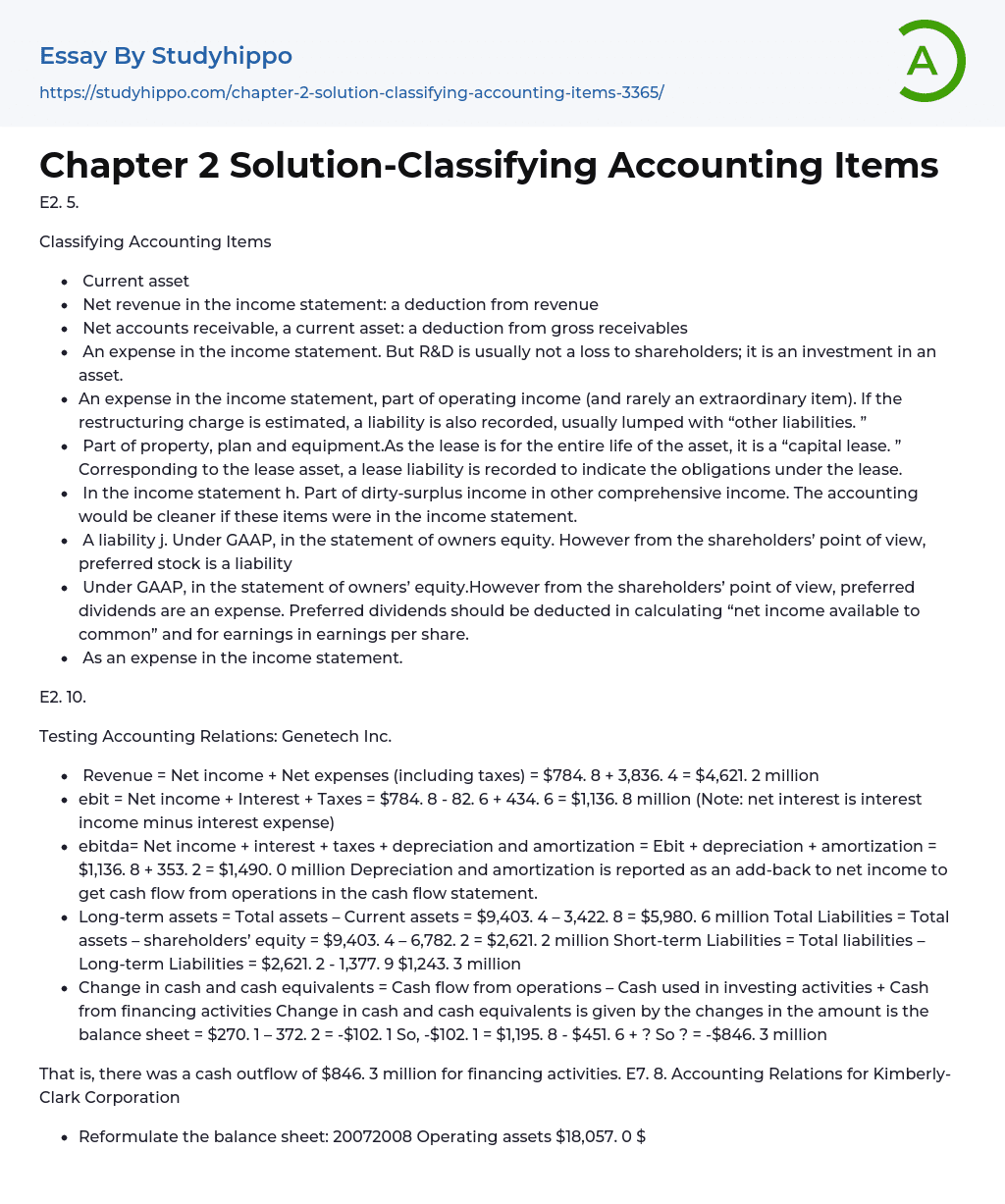

Chapter 2 Solution-Classifying Accounting Items Essay Example
Topics:
View Entire Sample
Download Sample
Text preview
Classifying Accounting Items
- Current asset
- Net revenue in the income statement: a deduction from revenue
- Net accounts receivable, a current asset: a deduction from gross receivables
- An expense in the income statement. But R&D is usually not a loss to shareholders; it is an investment in an asset.
- An expense in the income statement, part of operating income (and rarely an extraordinary item). If the restructuring charge is estimated, a liability is also recorded, usually lumped with “other liabilities. ”
- Part of property, plan and equipment.As the lease is for the entire life of the asset, it is a “capital lease. ” Corresponding to the lease asset, a lease liability is recorded to indicate the obligations under the lease.
- In the income statement h. Part of dirty-surplus income in other comprehensive income. The accountin
...g would be cleaner if these items were in the income statement.
- A liability j. Under GAAP, in the statement of owners equity. However from the shareholders’ point of view, preferred stock is a liability
- Under GAAP, in the statement of owners’ equity.However from the shareholders’ point of view, preferred dividends are an expense. Preferred dividends should be deducted in calculating “net income available to common” and for earnings in earnings per share.
- As an expense in the income statement.
Testing Accounting Relations: Genetech Inc.
- Revenue = Net income + Net expenses (including taxes) = $784. 8 + 3,836. 4 = $4,621. 2 million
- ebit = Net income + Interest + Taxes = $784. 8 - 82. 6 + 434. 6 = $1,136. 8 million (Note: net interest is interest income minus interest expense)
- ebitda= Net income + interest + taxes + depreciation
View entire sampleJoin StudyHippo to see entire essay
and amortization = Ebit + depreciation + amortization = $1,136. 8 + 353. 2 = $1,490. 0 million Depreciation and amortization is reported as an add-back to net income to get cash flow from operations in the cash flow statement.
That is, there was a cash outflow of $846. 3 million for financing activities. E7. 8. Accounting Relations for Kimberly-Clark Corporation
- Reformulate the balance sheet: 20072008 Operating assets $18,057. 0 $16,796. 2 Operating liabilities 6,011. 8 5,927. 2 Net operating assets (NOA) 12,045. 2 10,869. 0 (i) Financial obligations $6,496. 4 $4,395. 4 Financial assets 382. 7 6,113. 7 270. 8 4,124. 6 (ii) Common equity $ 5,931. 5 $ 6,744. 4 (iii)
- Free cash flow = Operating income – Change in net operating assets = $2,740. 1 – (12,045. 2 – 10,869. 0) = $1,563. 9
- NOA (end) = NOA (beginning) + Operating income – Free cash flow $12,045. 2 = $10,869. 0 + 2,740. 1
– 1,563. 9
Popular Essay Topics
- Accounts Receivable essays
- Auditor's Report essays
- Balance Sheet essays
- Costs essays
- Financial Audit essays
- International Financial Reporting Standards essays
- Tax essays
- Accountability essays
- Cash essays
- Principal essays
- Management Accounting essays
- Internal Control essays
- Accounting Software essays
- Cash Flow essays
- Accounting essays
- Andrew Carnegie essays
- Automation essays
- Business Cycle essays
- Business Intelligence essays
- Business Model essays
- Business Operations essays
- Business Software essays
- Cooperation essays
- Cooperative essays
- Corporate Social Responsibility essays
- Corporation essays
- Customer Relationship Management essays
- Family Business essays
- Franchising essays
- Harvard Business School essays
- Harvard university essays
- Human Resource Management essays
- Infrastructure essays
- Inventory essays
- Logistics essays
- Management essays
- Manufacturing essays
- Market essays
- Marketing essays
- Multinational Corporation essays
- News Media essays
- Online Shopping essays
- Quality Assurance essays
- Richard Branson essays
- Sales essays
- Selling essays
- Shopping Mall essays
- Small Business essays
- Starting a Business essays
- Stock essays



